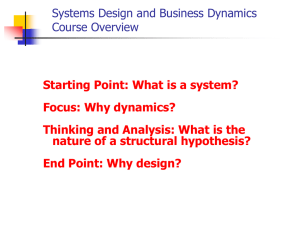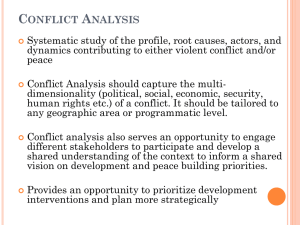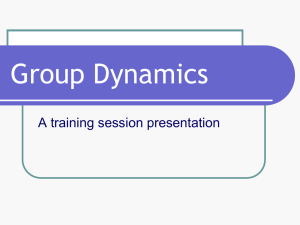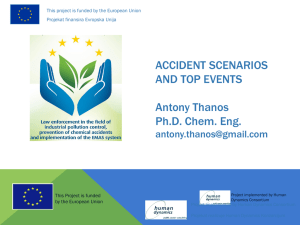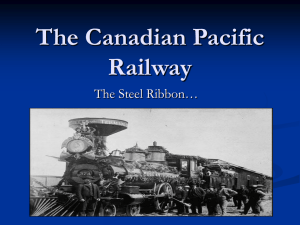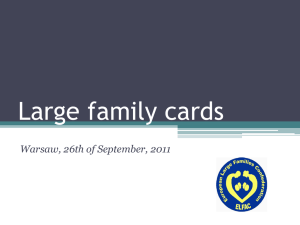pptx -> 4585.54 kb
advertisement
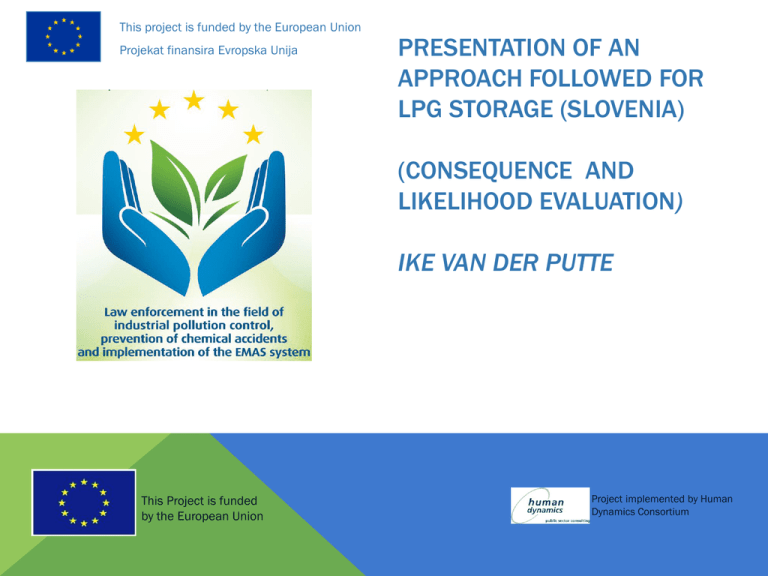
This project is funded by the European Union Projekat finansira Evropska Unija PRESENTATION OF AN APPROACH FOLLOWED FOR LPG STORAGE (SLOVENIA) (CONSEQUENCE AND LIKELIHOOD EVALUATION) IKE VAN DER PUTTE This Project is funded by the European Union Project implemented by Human Dynamics Consortium The establishment Butan Plin d.d. is situated in the industrial zone Šiška in northern part of Ljubljana Vertical LPG Storage Vessels (250m3) View of Site from Top of Vertical Storage Vessels This Project is funded by the European Union Railway Car unloading Station Cylinder Filling Station Project implemented by Human Dynamics Consortium Major-Accident Hazard Consequence Evaluation In order to appropriately evaluate their potential consequences, the major-accident hazards (category 1 hazards) identified should be subjected to a further assessment process. A representative ‘worst credible’ scenario should be used for evaluation purposes. Hose failure during railway car unloading, leading to loss of the contents of the railcar (50,000kg), was deemed the single worst credible case due to the quantities of LPG involved. The following effects of such an event were assessed as appropriate: • Thermal radiation from jet flame, pool fire or flash fire; • Explosion overpressures due to vapour cloud explosion; This Project is funded by the European Union Project implemented by Human Dynamics Consortium Fire and Explosion Modelling (1) Jet Fire Modelling When hydrocarbon gas/liquid is released under pressure, a jet flame will occur in the event of immediate ignition. Delayed ignition of a gas release may lead to an explosion which may burn back to a jet flame. Flame length and subsequent thermal radiation levels are of interest from such a fire. Pool Fire Modelling In the event of a liquid release from a tank, a pipe or a valve, a pool of liquid may form leading to the risk of a pool fire. The parameter of interest is the thermal radiation generated from such a fire. Vapour Cloud Modelling Combustion of a flammable gas-air mixture will occur if the composition of the mixture lies in the flammable range and a source of ignition is present. When a vapour cloud burns, the combustion may give rise to an overpressure. If an overpressure occurs, the event is a vapour cloud explosion. If no overpressure occurs, the event is a vapour cloud/flash fire. This Project is funded by the European Union Project implemented by Human Dynamics Consortium Fire and Explosion Modelling (2) A BLEVE occurs when a pressure vessel containing a flammable liquid, typically a liquefied gas, is exposed to heat from a fire (such as the pool or jet fire described above). The liquid begins to vaporise and the pressure within the vessel increases. The vessel fails leading to a sudden release of a large mass of pressurised, superheated liquid which rapidly vaporises. The essential features of a BLEVE are as follows: The vessel fails; The failure results in flash-off of vapour from the superheated liquid; The vapour ignites and forms a fireball. The accompanying effects of such an event are: Overpressure (Blast Missiles(Fragments) Fireball While it is noted that missiles and overpressures may be generated by a BLEVE event, the extent and consequences of such effects are very difficult to predict. Accordingly, attention is given to the principal consequence of a BLEVE, i.e. the thermal radiation generated by the resultant fireball This Project is funded by the European Union Project implemented by Human Dynamics Consortium EVALUATION OF MAJOR-ACCIDENT HAZARDS The following section describes the properties and potential hazards associated with LPG, the major-accident hazard scenarios identified and their implications at the site (software PHAST) Atmospheric Stability Class and Wind Speed The following atmospheric stability classes and wind speed combinations were used for all scenarios modelled: B1 Stability B, 1m/s wind D5 Stability D, 5m/s wind F2 Stability F, 2m/s wind These are considered to cover worst case and normal weather conditions for the site. Typical Directions at Wind Speeds Below 3m/s for Butan Plin Site This Project is funded by the European Union Project implemented by Human Dynamics Consortium Full Railway Car Release Scenario (1) Modelling was carried out using the largest railway car inventory, i.e. 90m3 or 50,000kg using a density of 550kg/m3, which is considered to be the worst credible case release for the site. There are a number of different possible elevations and directions for a release of LPG from a railway car. In order to determine the worst case release, the following were modelled: A horizontal release at 1m above ground level; A horizontal release at ground level; A downward release at 1m above ground level which impinges on the ground; A downward release at ground level which impinges on the ground. Each of these release types were modelled to determine the worst case. The worst case results only are reported. This Project is funded by the European Union Project implemented by Human Dynamics Consortium Full Railway Car Release Scenario (2) It is assumed that the flexible hose ruptures forming an 80mm diameter hole. The release rate from the ruptured hose/pipe is approximately 30kg/s. In the event of a release from a ruptured hose, 29% of the LPG will vaporise on release and the remaining 71% will fall to the ground as liquid, which will also vaporise. The hazards associated with a release of a full railway car of LPG include: • Jet fire at the ruptured hose; • Pool fire of the LPG; • Explosion of the vapour cloud; • Boiling liquid expanding vapour explosion (BLEVE). Each of these hazards was assessed individually and they are reported separately This Project is funded by the European Union Project implemented by Human Dynamics Consortium JET FIRE RESULTS Maximum Downwind Ground Level Distance from Point of Release to Reference Radiation Level for Jet Fire (m) Reference Radiation Level Weather B1 Weather D5 Weather F2 4.5kW/m2 197 157 180 12.5kW/m2 173 131 155 37.5kW/m2 149 111 134 37.5 kW/m2 Sufficient to cause damage to process equipment 12.5 kW/m2 Minimum energy required for piloted ignition of wood, melting plastic tubing, etc 2 4.5 kW/m Sufficient to cause pain to personnel if unable to reach cover within 20 seconds, however, blistering of skin (first degree burns) is unlikely This Project is funded by the European Union Project implemented by Human Dynamics Consortium From these results it is evident that personnel within 197m downwind of the railway car are likely to suffer injury. Process equipment within 149m of the railway car is likely to suffer damage. This Project is funded by the European Union Project implemented by Human Dynamics Consortium POOL FIRE RESULTS Maximum Downwind Distance from Centre of Pool to reference Radiation Level for Pool Fire (m) Reference Radiation Level Weather B1 Weather D5 Weather F2 4.5kW/m2 156 153 160 12.5kW/m2 95 104 101 37.5kW/m2 46 59 51 37.5 kW/m2 Sufficient to cause damage to process equipment 12.5 kW/m2 Minimum energy required for piloted ignition of wood, melting plastic tubing, etc 2 4.5 kW/m Sufficient to cause pain to personnel if unable to reach cover within 20 seconds, however, blistering of skin (first degree burns) is unlikely This Project is funded by the European Union Project implemented by Human Dynamics Consortium From the results it is evident that personnel within 160m downwind of the railway car are likely to suffer injury. Process equipment within 59m of the railway car is likely to suffer damage This Project is funded by the European Union Project implemented by Human Dynamics Consortium VAPOUR CLOUD EXPLOSION (1) The liquid spill will vaporise and join with the vapour flashing off on release. The cloud formed will disperse in the atmosphere. Explosive concentrations will persist downwind and an explosion will result if an ignition source is located. For the purposes of these calculations it is assumed that ignition can occur down to a concentration of 50% LEL. The worst case vapour cloud explosion will occur even at an ignition source 165m distance from the release . Table : Maximum Downwind Distances to LEL and 50% LEL Weather B1 Weather D5 Weather F2 LEL 129 87 100 50% LEL 165 120 130 Side View of LPG Vapour Cloud This Project is funded by the European Union Project implemented by Human Dynamics Consortium Overpressure damage effects The overpressures required to directly injure humans are significantly higher than those required to damage buildings. Injuries resulting from secondary impacts, such as building damage/collapse or flying debris, are more likely to occur and therefore the distances to the following overpressures are usually determined for each scenario modelled: 0.207 bar 0.138 bar 0.021 bar Steel frame building distorted and pulled away from foundations; Rupture of storage tanks. Serious damage to buildings and equipment. Partial collapse of walls and roofs of houses. “Safe distance” – 95% probability of no serious damage beyond this point; 10% of glass windows broken. This Project is funded by the European Union Project implemented by Human Dynamics Consortium VAPOUR CLOUD EXPLOSION (2) Maximum Downwind Distance from Release to Reference Overpressure for Vapour Cloud Explosion (m) Reference Overpressure Weather B1 Weather D5 Weather F2 0.021 bar 697 382 653 0.138 bar 299 180 265 0.207 bar 268 165 235 From these results, it is possible that personnel could suffer injury and that minor structural damage could occur up to 697m from the release. Serious damage to equipment and buildings is likely to occur up to 268m from the release This Project is funded by the European Union Project implemented by Human Dynamics Consortium Boiling Liquid Expanding Vapour Explosion If the leaking railway car or one of the adjacent railway cars is exposed to thermal radiation from the pool or jet fire for a period of time, the LPG will begin to boil, i.e. become superheated. As the pressure in the vessel increases due to vaporisation and reaches the maximum pressure rating for the vessel, i.e. 16.75 bar, the vessel could fail generating a BLEVE. Maximum Downwind Distance from Release to Reference Radiation Level for BLEVE (m) Reference Radiation Level Weather B1 Weather D5 Weather F2 4.5kW/m2 527 527 527 12.5kW/m2 324 324 324 37.5kW/m2 178 178 178 From these results it is evident that personnel within 527m downwind of the railway car are likely to suffer injury. Process equipment within 178m of the railway car is likely to suffer damage This Project is funded by the European Union Project implemented by Human Dynamics Consortium Recommendations for Emergency Planning Summary of Worst Case Results for Thermal Radiation and Overpressure Effects for a Full Railway Car Release of LPG Reference Level B1 Weather Maximum Downwind Distance from Release to Reference Radiation Level for BLEVE (m) 4.5kW/m2 530 12.5kW/m 2 320 37.5kW/m 2 180 Maximum Downwind Distance from Release to Reference Overpressure for Vapour Cloud Explosion (m) 0.021 bar 700 0.138 bar 300 0.207 bar 270 These results have been superimposed on local area drawings for emergency planning purposes This Project is funded by the European Union Project implemented by Human Dynamics Consortium Unconfined Vapour Cloud Explosion Impact Zones This Project is funded by the European Union Project implemented by Human Dynamics Consortium BLEVE Thermal Radiation Impact Zones This Project is funded by the European Union Project implemented by Human Dynamics Consortium Frequency Analysis A fault tree has been developed to assess the likelihood of the following events: • An uncontrolled release of LPG, i.e. release occurs and the operator fails to re-activate the excess flow valve leading release of the full inventory of a railway car; • An LPG fire or explosion, i.e. the release is ignited; • An uncontrolled LPG fire/BLEVE, i.e. failure of the deluge system in the event of an ignited release leading to an uncontrolled pool/jet fire which impacts on an adjacent railway car leading to a BLEVE Each of these events is represented by a separate gate on the fault tree. This figure represents the current system at Butan Plin, i.e. a flexible hose unloading system with manual re-activation of the excess flow valve in the event of a release. Butan Plin is currently considering installing a new LPG unloading system This Project is funded by the European Union Project implemented by Human Dynamics Consortium Figure 1: Fault Tree for Uncontrolled LPG Fire/BLEVE per Year with Flexible Discharging Hose Connection This Project is funded by the European Union Project implemented by Human Dynamics Consortium Figure 2: Fault Tree for Uncontrolled LPG Fire/BLEVE per Year with Fixed Unloading Arm System This Project is funded by the European Union Project implemented by Human Dynamics Consortium Butan Plin is considering installing a new LPG unloading system: Scenario (Note 1) Existing System (Note 2) Modified System (Note 2) Uncontrolled LPG Release from a Railcar (Gate LPGPERYR) 1.09 x 10-5 per year (1 in 91,743 years) 1.89 x 10-7 per year (1 in 5.3 million years) LPG Fire or Explosion (Gate FIRE) 1.09 x 10-5 per year (1 in 91, 743 years) 1.89 x 10-7 per year (1 in 5.3 million years) 1.18 x 10-7 per year (1 in 8.5 million years) 2.05 x 10-9 per year (1 in 487 million years) Uncontrolled Fire/BLEVE (Gate BLEVE) Notes: 1. It has been assumed that an ignition source will be available 2. This figure could be further reduced if the deluge system were automatically activated This Project is funded by the European Union Project implemented by Human Dynamics Consortium CONCLUSIONS (1) Five major-accident scenarios were identified during the major-accident hazard review. Each of these scenarios involved a release of LPG which could potential give rise to a jet flame, a pool fire or a vapour cloud explosion. From these five major-accident scenarios, a representative ‘worst credible’ scenario was identified for the site and this scenario was used for evaluation purposes. This scenario involved rupture of a flexible hose during LPG railway car unloading leading to a release of the full contents of the railway car. A ‘worst probable’ scenario was identified and this was also evaluated. This scenario involved rupture of a flexible hose during railway car unloading and a 60 second release of LPG prior to manual reactivation of the excess flow valve. A ‘worst possible’ scenario for the site was identified which involved catastrophic rupture of one of the larger storage vessels on site. Modelling of this scenario has been carried out and the results have been given to the local Emergency Response Unit. This Project is funded by the European Union Project implemented by Human Dynamics Consortium CONCLUSIONS (2) Modelling of the consequences of the worst credible case indicates that in the event of these accidents occurring, there are potentially significant consequences both on- and off-site. It also confirmed the requirement for an off-site emergency response plan. The likelihood of the worst credible case occurring, i.e. an uncontrolled LPG release from a railway car, was also assessed. For comparative purposes, the likelihood of this event was analysed following implementation of an improved means of unloading, i.e. a fixed LPG loading arm. This Project is funded by the European Union Project implemented by Human Dynamics Consortium References • Lees, Frank, 1996. Loss Prevention in the Process Industries, ‘Hazard Identification, Assessment and Control’, Volume 2, 2nd Edition. • United Nations Environment Programme, 1992. Hazard Identification and Evaluation in a Local Community, Technical Report No. 12, UNEP IE/PAC). • I. van der Putte. Phare final report 2002. Planning for emergencies involving Dangerous Substances for Slovenia. Regional Environment Accession Project Nethconsult – BKH Consulting Engineers/RPS Subcontractors: AEA Technology; URS Dames & Moore; EPCE; Project Management Group; REC Hungary This Project is funded by the European Union Project implemented by Human Dynamics Consortium This Project is funded by the European Union Project implemented by Human Dynamics Consortium
